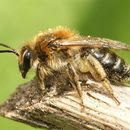Life Cycle
provided by EOL authors
Mining bees are ground nesters and most are solitary, although they will form aggregations. Bees emerge in the spring, with males emerging slightly before females, and mating occurring shortly thereafter. After mating, females begin constructing their nests - a vertical tunnel lined with a shiny water-proof secretion and side cells. Small mounds of soil are often left above ground around the nest. In each cell the female places a pollen ball and lays one egg, usually laying less than 30 eggs in total. Once the nest is finished, the female caps the nest with soil. The eggs hatch into larvae, which consume the pollen balls, and then enter hibernation. During late summer, the larvae pupate and turn into adult bees, emerging from the nest the following spring. After emerging, adults live for about one month.
- license
- cc-publicdomain
- copyright
- National Biological Information Infrastructure (NBII) at http://www.nbii.gov
Brief Summary
provided by EOL authors
Mining bees (Andrena spp.), also known as miner bees, sand bees, and digger bees, are named for their practice of nesting underground. These bees are found worldwide, except in Oceania and South America, and are native to North America. Mining bees are small to medium sized bees, ranging from six to 16 mm long. Males are slightly smaller than females. They are brown to black with whitish abdominal bands and are moderately hairy. Mining bees nest in exposed, sandy soils with good drainage. Their nests are often built near or under shrubs, and in banks, hills, and road cut-outs.
- license
- cc-publicdomain
- copyright
- National Biological Information Infrastructure (NBII) at http://www.nbii.gov
Pollinator
provided by EOL authors
Mining bees are small to medium sized bees with hairy bodies. Their hairy bodies collect large amounts of pollen, which is then carried on the hind legs in pollen baskets. Females tend to return to the same flower patches, visiting near-neighbors of the flower previously visited. Mining bees are effective and common pollinators of many crops, including low bush blueberry (Vaccinium angustifolium), alfalfa (Medicago sativa), and apple (Malus domestica) and other fruit trees. Along with crop plants, mining bees pollinate plants in natural systems, too, specializing on a narrow range of plants as pollen sources. Examples include spotted coral-root (Corallorhiza maculata), small white lady's-slipper (Cypripedium candidum), yellow carpet (Blemnosperma spp.), meadowfoam (Limnanthes spp.), goldfield (Lasthenia spp.), and skyblue (Downingia spp.).
- license
- cc-publicdomain
- copyright
- National Biological Information Infrastructure (NBII) at http://www.nbii.gov

